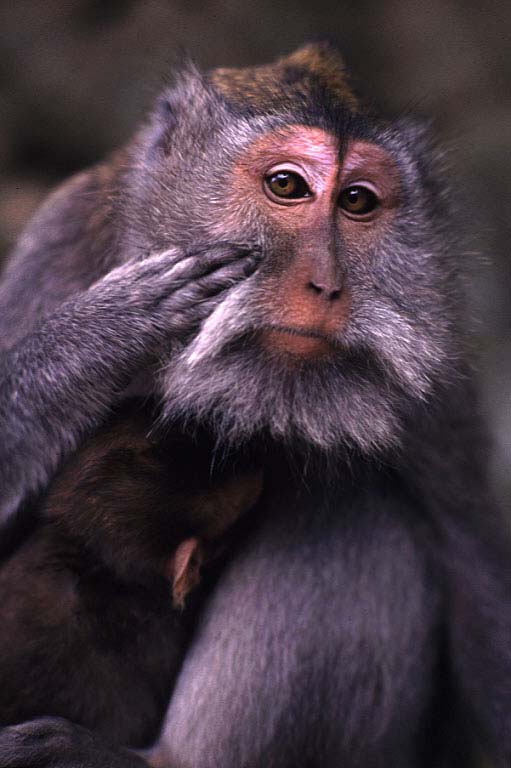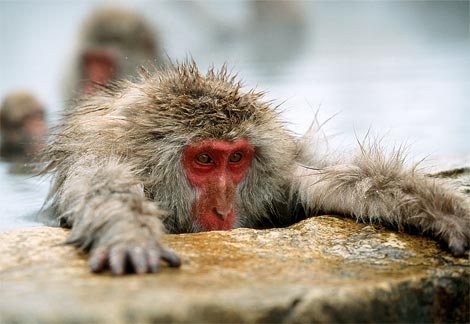
February 12, 2008

Are the reports of a strange new monkey related to Macaca fascicularis, pictured above? Or are they more clearly aligned with Japanese macaques? Are they a new species, as yet undiscovered? Or have exotic pet traders released some rare snow monkeys from Japan in the Philippines?
A group of red-faced monkeys that can mimic human laughter has been sighted in the mountain ranges of Sal-dab, a sacred mountain in Northern Mindanao, The STAR learned recently.
The monkey that mimics human voice is known to natives as Uma-ay and is believed to bring a curse on whoever sees it.
According to local folklore, whoever sees the creature will lose his way in the jungle or may encounter misfortune, accident or even death along the way.
The monkey, which is not included in the list of newly discovered animal species of the Department of Environment and Natural Resources (DENR), lives in high trees and subsists on fruits of wild trees in the forest.
The DENR Protected and Wildlife Bureau (PAWB) has reported sighting 14 new animal species since 1998.
Most of the creatures, however, were of the rat and bat species.
A tribal trapper interviewed by The STAR last year said the Uma-ay looks human because they do not have hair on their faces and can mimic the human voice. They grow up to the size of the native monkeys in the area.
“The laugh of an Uma-ay is an ominous sign, it means misfortune or even death,” the tribal hunter said in the Hiliga-onon dialect.
The hunter declined to name the location of the place where the Uma-ay can be found but said it is sacred ground where tribal elders offer sacrifices and perform yearly rituals to appease their gods.
Aside from the Uma-ay, the tribal folk also mentioned that they sighted an unnamed feathered bird that has mammalâs hair.
Just like the Uma-ay, the bird also mimics the human voice but its favorite sound is the cry of a newborn baby.
The natives call the creature Ukang (owl) or gulus (ghost). This nocturnal bird is often heard making noise at night but only a few elders have actually seen it.
Tribe members believe that the Uma-ay mimics the human voice to drive away the Kalumbata (monkey-eating eagle), which regularly hover in the area in search for food.
It is said that Uma-ays would simultaneously sound their laughter to confuse the marauding eagles.“Laughing, red-faced monkeys spotted in Mindanao wild”, by Perseus Echeminada, The Philippine Star, February 12, 2008,
Chad Arment, author of Boss Snakes and Cryptozoology: Science and Speculation, has this to say about these ethnoknown reports: “Regarding the primates noted,…Mindanao is home to one known species of primate, the crab-eating macaque, Macaca fascicularis, and it should be fairly common there from what I’ve seen. It does not, however, have the bright red-face that you might see in, for example, the Japanese macaques — at least not in any photographs I’ve seen. Most descriptions of the macaques on Mindanao are of brownish or gray coloration all over. So, it seems possible that the red-faced monkeys here could be a variant. Whether they’re a possible new species, I don’t think can be speculated without either better descriptions as an ethnoknown, or a specimen. And, of course, there’s mention of a bird with “hair,” but there’s a bit too much folklore and too little description to be overly confident in placing that as a cryptid.”

Another photograph of the crab-eating macaque (above) Macaca fascicularis.

The Japanese snow monkey or Japanese macaque (Macaca fuscata) does display a typical red-face.
About Loren Coleman
Loren Coleman is one of the world’s leading cryptozoologists, some say “the” leading living cryptozoologist. Certainly, he is acknowledged as the current living American researcher and writer who has most popularized cryptozoology in the late 20th and early 21st centuries.
Starting his fieldwork and investigations in 1960, after traveling and trekking extensively in pursuit of cryptozoological mysteries, Coleman began writing to share his experiences in 1969. An honorary member of Ivan T. Sanderson’s Society for the Investigation of the Unexplained in the 1970s, Coleman has been bestowed with similar honorary memberships of the North Idaho College Cryptozoology Club in 1983, and in subsequent years, that of the British Columbia Scientific Cryptozoology Club, CryptoSafari International, and other international organizations. He was also a Life Member and Benefactor of the International Society of Cryptozoology (now-defunct).
Loren Coleman’s daily blog, as a member of the Cryptomundo Team, served as an ongoing avenue of communication for the ever-growing body of cryptozoo news from 2005 through 2013. He returned as an infrequent contributor beginning Halloween week of 2015.
Coleman is the founder in 2003, and current director of the International Cryptozoology Museum in Portland, Maine.
Filed under Breaking News, Cryptotourism, CryptoZoo News, Cryptozoologists, Cryptozoology, Eyewitness Accounts